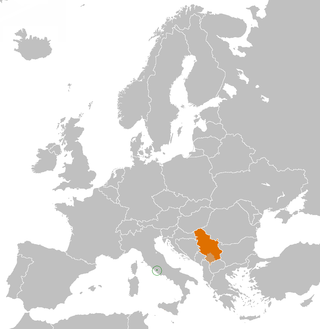Top Qs
Timeline
Chat
Perspective
Holy See–Serbia relations
Bilateral relations From Wikipedia, the free encyclopedia
Remove ads
Holy See and Serbia maintain diplomatic relations established between the Holy See and Kingdom of Yugoslavia in 1919. From 1919 to 2006, the Holy See maintained relations with the Kingdom of Yugoslavia, the Socialist Federal Republic of Yugoslavia (SFRY), and the Federal Republic of Yugoslavia (FRY) (later Serbia and Montenegro), of which Serbia is considered shared (SFRY) or sole (FRY) legal successor.[1]
Remove ads
History

The baptism of Grand Prince of Serbia Stefan Nemanja was latin rite catholic, in the Serbian Medieval State of Duklja.
The coronation of Grand Prince of Serbia Stefan the First-Crowned (1165–1228) was performed by a legate of Pope Urban II, which led some Serbian historians to conclude that Stefan converted to Catholicism.[2]
Stefan's third wife, Venetian noblewoman Anna Dandolo, a Catholic, became Queen of Serbia and was mother to Stefan Uroš I. Popular legend claims that the Žiča Monastery, seat of the Serbian Orthodox Church between 1219–1253, was intentionally constructed on the halfway between Rome and Constantinople.[3]
Remove ads
Vatican's stance on Kosovo
The Holy See has decided to withhold recognition of Kosovo[a] as part of an agreement with Russia and the Russian Orthodox Church, and this has led to a warming of Vatican-Serbia relations.[4]
Resident diplomatic missions
See also
Notes
- Kosovo is the subject of a territorial dispute between the Republic of Serbia and Republic of Kosovo.
References
External links
Wikiwand - on
Seamless Wikipedia browsing. On steroids.
Remove ads

